Summary of The International Style
Today when people speak of the "architecture of the modern movement," they are usually referring to the International Style - especially the gleaming steel, glass, and concrete forms of its most famous buildings. More of a movement than a mere aesthetic, the International Style emerged in Europe partly as a response to the cataclysm of World War I and related events. Its use in postwar housing gave it renown as a symbol of social and industrial progress, and not surprisingly, the International Style often resonated with leftist political groups. In the face of opposition from totalitarian regimes in the 1930s, many of the International Style's European proponents resettled in the United States, where economic expansion after World War II allowed it to flourish, particularly in skyscraper construction.
This, along with the growth of rapid postwar intercontinental communication, allowed it to become a truly global architecture. But the inability of the International Style's supporters to solve social problems as its founders had hoped, coupled with its rigid formal monotony, prompted many architects in the 1960s to seek new design directions that reflected an increasingly diverse, commercialized, and post-industrial society. While few architects today call themselves adherents of the International Style, an equally small number would say it has not in some way influenced their work.
Key Ideas & Accomplishments
- The International Style is often thought of as the "architecture of the machine age," which symbolized for many the crystallization of modernism in building design. This became particularly true after World War II, when the postwar economic building boom made the International Style a kind of "unofficial" American architecture.
- Often called "minimalist" architecture, International Style buildings are well-known for the way they seem to strip away all extraneous ornament from the structure, leading to an extreme blurring of interior and exterior space, the exposure of buildings' construction with unvarnished honesty, and the glorification of modern industrial materials: chiefly, steel, concrete, and glass.
- The International Style was one of the first architectural movements to receive renown and be adopted unequivocally on every inhabited continent. It became a global symbol of modernity both before and after World War II, especially in Latin America and Asia, where nations felt a keen desire to industrialize and compete politically and economically with traditional powers in Europe and North America.
- The term "International Style" was coined in 1932 by an eponymous exposition of European architects at the Museum of Modern Art in New York curated by Henry-Russell Hitchcock and Philip Johnson to describe an ethos of construction purely in terms of materials and space, with virtually no reference to the sociopolitical dimension, as had been highly emphasized in Europe. This differentiated the International Style between its understanding in Europe versus in the USA.
Artworks and Artists of The International Style
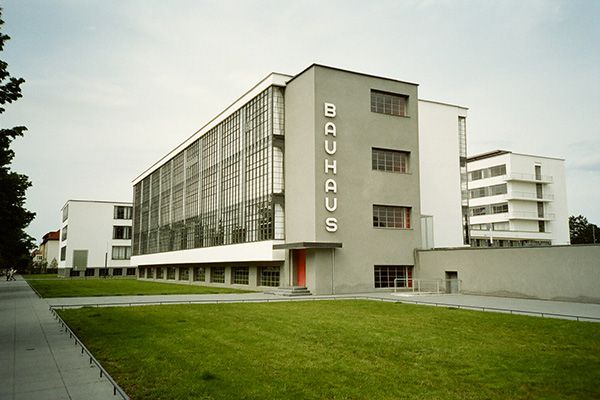
Bauhaus, Dessau, Germany
Home to the state-supported school for the applied arts, the Bauhaus was founded in Weimar in 1919 by Walter Gropius, but moved to Dessau in 1925 when political conditions in the latter became more favorable to its left-leaning educational climate. Gropius designed the school's new permanent home along with the faculty residences nearby that same year.
The pinwheel-plan institutional building is composed of an asymmetrical set of prismatic structures of reinforced concrete. Each section - dormitories, studio spaces, offices, and refectory - uses a different design that delineates its respective function with remarkable clarity, particularly the use of massive glass curtain walls for the studio spaces to maximize the admittance of natural light. The wraparound corners of these windows, which emerge from the plane of the rest of the facade, enable one to see through two sides of the structure simultaneously, a feature that prompted architectural critic Reyner Banham to call it the first "Cubist" building. The complex only housed the Bauhaus for four years before the political climate became untenable and it moved to Berlin, closing for good under Nazi pressure in 1933.
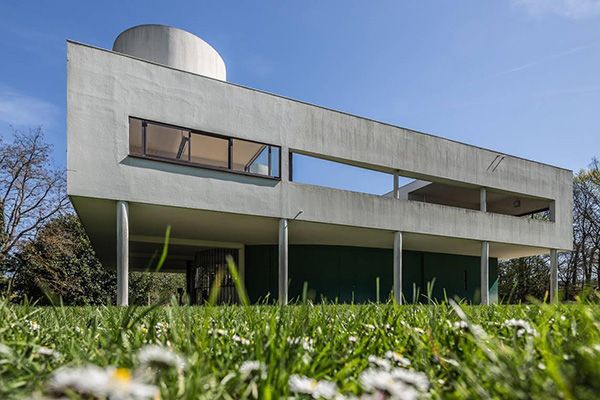
Villa Savoye, Poissy-sur-Seine, France
The Villa Savoye is the last of Le Corbusier's houses that he designed during the 1920s, and fittingly is considered the summation of his "Five Points of a New Architecture" elucidated in his treatise Vers une architecture (1923). The pilotis, or thin point-support columns, are arranged in a near-perfect grid that provides the architect almost complete freedom in the designs of both the floor plan and the facades. The second floor, the main living space, is characterized by the ribbon windows that provide unencumbered views of the landscape - fostering the strong connection between nature and the machine - and it is crowned by a roof terrace.
Built entirely out of the industrial materials of steel, concrete, and glass, the Villa Savoye exhibits several links with the modern means of transportation that fascinated Le Corbusier. The terrace features a sculptural wall whose curved forms echo the smokestacks of ocean liners, a relationship which is underscored by the placement of the house within a large lawn, much like a ship sailing through a vast sea; and in the metal ship-deck railings of the ramps that connect the house's three levels. Meanwhile, the curve of the driveway as it snakes around the first level uses the exact turning radius of a 1929 model Voisin - the automobile manufacturer that had supported Le Corbusier's work throughout the decade. The villa thus represents the way Le Corbusier conceived of a dwelling as "a machine for living."
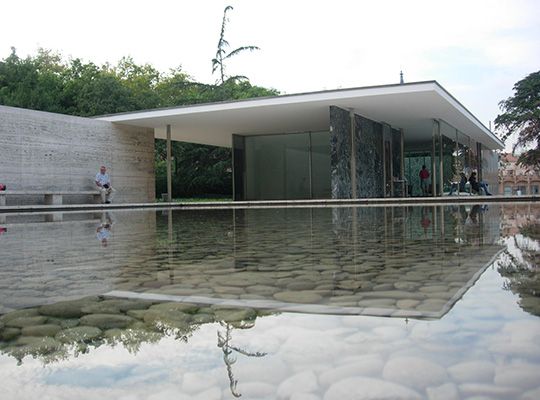
German Pavilion, Barcelona, Spain
Mies and Lilly Reich together designed the German Pavilion for the 1929 World's Fair in Barcelona - a structure which now ranks among the most significant temporary structures ever built, particularly for an international exposition. Demolished after the fair, it was reconstructed in 1986 using the original plans, now in the collection of the Museum of Modern Art in New York. It constitutes Mies' most succinct statement in the reduction of a building to the minimal requirements to define space: a handful of columns elevated on a platform juxtaposed with asymmetrically-arranged opaque and transparent wall planes, supporting a flat roof.
The Pavilion functioned during the fair as simply a reception space for dignitaries, as the Weimar government had other space for actual exhibits. Though there is an extreme emphasis on horizontality, the platform of travertine (a common stone used in ancient classical monuments) elevates it much like a Greek temple, with a structural clarity to match. But also here we see the fineness of materials: the cruciform-plan steel columns are chrome-plated, and the interior is ornamented solely with a red curtain, while the colored onyx walls are cut to expose the diamond pattern, all of which recalling an attention to refinement and craftsmanship that is balanced with the building's clear machine-made qualities. It therefore exemplifies the visual form of Mies' famous dictum, "Less is more."
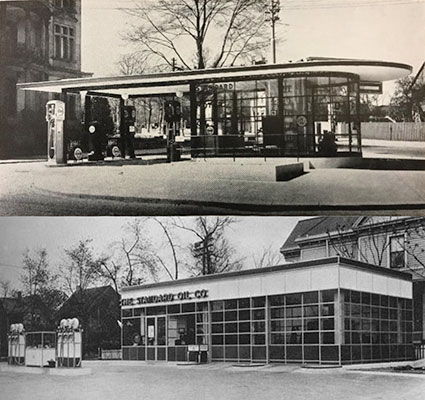
Filling Stations
The International Style proved to be a perfect idiom for the new, modern building type of the roadside automobile filling station. Both of these structures were included in Hitchcock and Johnson's book The International Style that followed the pair's landmark exhibition of 1932 at the Museum of Modern Art.
They demonstrate the ideal way in which essentially miniature industrial buildings serve a simple, functional purpose. They consist of individual pavilions distinguished by large expanses of glass curtain walls set into a steel structure, topped by a flat roof; in the case of Borkowsky's station (top), the pumps are even covered by a cantilevered canopy. Eschewing all exterior ornament, the stations suggest the minimal, economical use of industrial building materials to serve the simple utilitarian purpose of refueling cars efficiently. This efficiency is only enhanced by the clarity of structure and volume in each station, which also communicates the transparency and honesty of the business. Their construction forecasted the mushrooming popularity of these structures in the postwar era, which (especially in North America) was specifically designed around the widespread use of the automobile as the primary means of everyday transit. In essence, the most important aspect of these two gas stations is their role in establishing the tenets of a particular modern building type, which has remained virtually unchanged to the present day.
Kassel, Germany and Cleveland, Ohio, USA
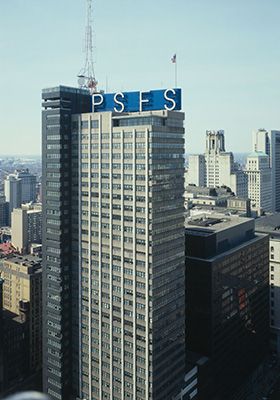
Philadelphia Savings Fund Society (PSFS) Building, Philadelphia, PA, USA
The PSFS Building was the only significant structure to come from the short-lived partnership of Howe & Lescaze, but it gave both men architectural immortality. The brainchild of the Swiss-born Lescaze, who had immigrated to the USA in 1920 and kept in tune throughout the decade with progressive European architectural currents, the PSFS Building was the first International Style skyscraper to be built in the USA, the birthplace of the building type. It was also the first tall building in the country to be air-conditioned, a necessity when it opened in humid central Philadelphia on August 1st, 1932.
Climatization represented just the tip of the iceberg of the building's innovative character. It was a radical departure from the traditional symmetrical classicism of bank architecture, with a tower using a T-shaped plan supported on a base of retail shops at street level. The double-height banking hall on the second floor, with a curtain wall of windows, was reached by escalators, and a streamlined aesthetic that combined polished steel, brick, wood, and expensive stone exuded a distinctly modern corporate identity. At the top of the tower, the giant "PSFS" neon sign in sans-serif typography symbolized the institution's efficiency, energy, and power, and even today it remains a linchpin of the Philadelphia skyline. Too radical to set a trend at the outset of the Great Depression, the PSFS Building would not be followed by another International-Style American skyscraper until after World War II.

United Nations General Assembly Building and Secretariat, New York, NY, USA
The construction of the headquarters of the United Nations, an organization that represented a desire for international cooperation instead of competition in the new post-World War II global order, was itself a highly symbolic process. It was mirrored by the choice of architects, which consisted of an international design team of twelve architects, including Le Corbusier and Oscar Niemeyer, headed by the Americans Wallace Harrison and Max Abramovitz. While each architect submitted his own design, ultimately a hybrid between Niemeyer and Le Corbusier's two proposals was chosen after much lobbying by the Swiss architect for his design to be built, though the actual constructed version was closest to Niemeyer's scheme.
The original complex, which has been expanded significantly in subsequent years, is renowned for the clarity of its conception, with three structures on the long site between First Avenue and the East River in midtown Manhattan: a low, horizontal block of meeting rooms, the tall Secretariat tower of offices, and the fan-shaped General Assembly building, surrounding an open plaza that arguably symbolizes the intermingling of cultures and nations. The explicit functional shape of the Assembly building suggests the democratic nature of the institution, while the office tower, raised on pilotis, exemplifies the sense of order, integrity, and transparency of the UN's operations. As one of the first International Style skyscrapers built after the war, it became a prototype for the architectural identity of corporations and institutions in the USA and elsewhere, aiding greatly in the dissemination of the International Style as the architecture of the modern postwar world.
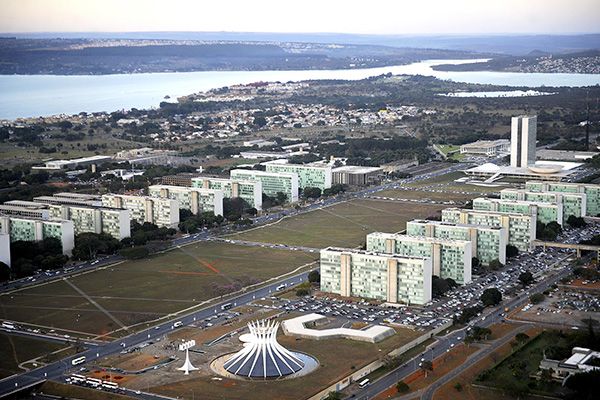
Plan for Brasilia, Brazil
The construction of the city of Brasilia as Brazil's new capital in the 1950s was a milestone for the country, as it sought to move the government to a new centralized location, away from Rio de Janeiro, Brazil's old capital on the Atlantic coast tied to its colonial past. The opportunity to begin anew on an undeveloped site likewise represented an opportunity to elevate Brazil's global image as a nation on par with the traditional Western powers. International Style architecture and planning for the new capital was seen as the visual crystallization of this ascendancy, and entrusted to the architects Lucio Costa and Oscar Niemeyer, both longtime admirers of Le Corbusier, who had welcomed the Swiss architect to Brazil in the 1930s.
Costa and Niemeyer's plan of Brasilia was laid out using two grand axes, one running roughly east-west - along which ran the governmental buildings - and one curved like a reverse C that crossed the first axis at the center, along which ran the commercial and residential districts. The layout thus appeared like the body of an airplane seen from above, fitting for a city born at the beginning of the jet age and reachable from the world beyond chiefly by airplane. (The airport was placed at the south end of the curved axis.) Prismatic steel-and-glass skyscrapers surrounded by ample green space characterize nearly the entirety of the building program, from housing to government ministries.
In retrospect, the scheme for Brasilia, however, created numerous problems. The plan's massive scale anticipated that all practical ground transportation would take place by car or bus on broad boulevards, which has invited circulation problems, pollution, and precluded the use of other forms of transit. This scheme produces an endless (and arguably disorienting) monotony and, particularly in the giant apartment blocks, divides inhabitants into uniform cells that are disconnected from public space, thereby destroying a sense of community.
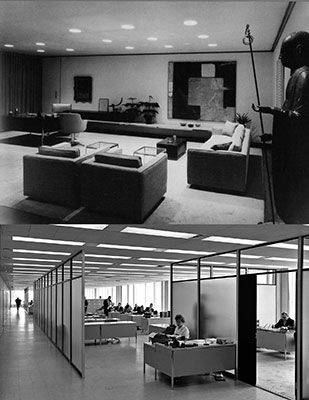
Chase Manhattan Bank
The Chase Manhattan Bank tower was the first International Style skyscraper to be constructed in lower Manhattan, where tall buildings traditionally had used a variety of revivalist and picturesque styles. Both its aesthetic and the choice of Skidmore, Owings & Merrill as the architects exemplify the corporate identity that modern architecture came to represent during the 1950s in the United States. Shown here are then-president David Rockefeller's office (at top) and employee desks in an individual department.
Just as the exteriors of International Style skyscrapers came to embody the precision of the modern machine age, with their stark rectilinearity and structural clarity, their interiors likewise exemplified an ordered corporate environment. The point-support skyscraper structure allowed for the maximum flexibility of interior space for employee work areas, which were often subdivided with gridded moveable partitions, sometimes even creating private offices. Austere metal desks arranged in precise rows embody the sense that the corporate workforce, which arrived and departed by the clock, constituted a well-oiled machine that processed transactions with ease, regularity, and transparency. Recessed lighting throughout the building accentuates the large axial expanses of space.
Rockefeller's own office, while clearly more comfortable, nonetheless exudes a sense of restraint and precision that harmonizes with the rest of the building's interiors. Even the padded chairs, couch, and coffee tables are arranged in a precise grid, accentuated by the rather spare decor, including the rectilinear modern painting on the far wall. The unity between these two interiors thus suggests that the tight sense of structure, protocol, and efficiency is seamless from the top of the corporate ladder to the bottom.
New York, NY
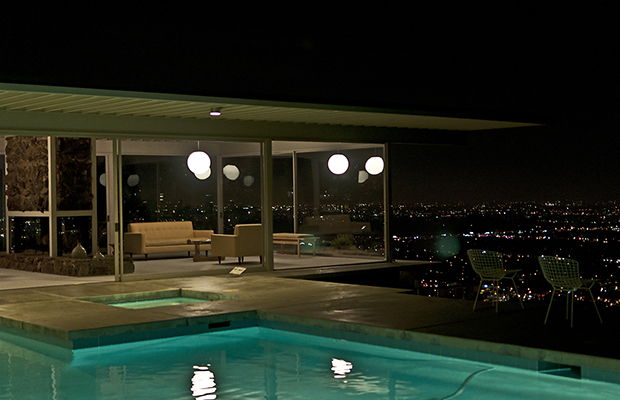
Case Study House #22 (Stahl House)
The Stahl House is one of the most recognizable residences in the Case Study House Program, the experimental series of modern houses in southern California sponsored by and featured prominently in John Entenza's Arts and Architecture magazine between 1945 and 1962. Its design exemplifies the program's commitment to exploring the use of modern industrial materials in designing single-family residences. The L-shaped steel-frame structure, perched on a cliff overlooking Los Angeles, was the brainchild of Pierre Koenig, one of the region's young, up-and-coming architects who designed multiple houses for the latter stages of the Program's run.
The key feature of the interior of the Stahl House is, ironically, the way in which the building dissolves as much as possible the line between interior and exterior, most dramatically seen in the living room wing that cantilevers over the edge of the cliff and is enclosed by curtain walls on three sides. The corrugated steel of the ceiling continues uninterrupted from the exterior patio to the interior. The slightest distinction is made between rooms, with a central fireplace marking the center of the living room, which flows seamlessly into the kitchen, all of which is made possible by the spans created by the steel frame, while the low furniture provides the minimal definition necessary for the interior spaces to function. Together, the clarity of minimal structure and maximum spatial flow make the Stahl House one of the best examples of an International Style interior.
Los Angeles, California
Beginnings of The International Style
The International Style arose from several strands of architectural and political thought in the 1910s. First, it often has been said to have grown out of a fascination with buildings for a modern industrialized age, especially factories and warehouses, which demanded utilitarian designs that included ample natural lighting and flexible interior space for machinery or storage for huge quantities of items, with minimal ornamentation of the structure. Such structures also spoke to the efficiency of construction and the solidity of materials. In Germany, such thought was visible in the steel-framed turbine factory in Berlin for Allgemeines Elektrisitäts Gesellschaft - the German General Electric - designed by company architect Peter Behrens between 1907 and 1910. At the time, Behrens simultaneously employed three seminal figures in the history of the International Style: Walter Gropius, Charles-Édouard Jeanneret (later known as Le Corbusier), and Ludwig Mies van der Rohe. Soon afterwards, Gropius left Behrens' office and opened his own practice with Adolf Meyer; they immediately received a commission for the new Fagus Shoe Factory at Alfeld-an-der-Leine in 1911, whose large glass curtain walls would be equally as inspiring for progressive architects.
Le Corbusier also left Behrens' employ shortly afterwards for a trip of several months to the Eastern Mediterranean, where he became keenly attracted to the purity of geometric form in Greek architecture, and later, to the American examples of vast concrete industrial structures such as grain silos, and the purity of their naked industrial volumes, which reappeared in the forms of still-life objects of his Purist paintings in the 1920s. In 1914, Le Corbusier patented a set of prototypes called the "Dom-ino Houses" that used a point-support system of columns supporting large spans of floor space, all made of reinforced concrete, which allowed the architect complete freedom in the design of all facades. This design would prove central to his later work and would evolve into his famous Five Points of a New Architecture by 1923.
Le Corbusier was also fascinated by new forms of transportation such as the automobile, whose machinery he likened to the logical extension of the human body and whose continued refinement and improvement he saw as the relentless pursuit of a "standard" of typological perfection.
The Destruction of World War I and Rebuilding Efforts
The cataclysm and large-scale destruction of World War I confirmed the undeniable mechanized direction of Western society. While many sought a refuge from the horrors wrought by industrialization, others such as Le Corbusier embraced it, arguing that machines were the key to promoting hygiene and workplace efficiency. Arguably, the use of industrial materials that could be mass-produced and quickly erected, like iron, steel, and concrete, was a critical advantage in the vast reconstruction efforts in the war's aftermath, particularly with respect to housing displaced populations.
Many were also inspired by the example of the Russian Revolution of 1917, which initially promised the creation of a new, classless society based on an industrialized proletariat. Though Russian industry lagged far behind other countries throughout the 1910s and '20s, architects there such as Vladimir Tatlin developed an architecture called Constructivism that was one of the earliest examples of the International Style. Constructivist architects imagined geometric institutional structures and housing units made of steel frames and transparent glass walls, with the frank exterior exposure of mechanized services such as elevators. The most famous example was Tatlin's unbuilt Monument to the Third International (1917), intended to house the new Soviet government.
The Coalescence of the International Style
The early 1920s saw the simultaneous elucidation in both France and Germany of the tenets of architectural design that would define the International Style. Because the economic conditions in Europe remained difficult in the aftermath of the war, many of these ideas remained simply projects disseminated in architectural magazines. The magazine G, for example, became one of the leading German periodicals devoted to modern architecture, and it was here that Ludwig Mies van der Rohe published projects for Berlin skyscrapers in 1921-22. These consisted of steel-framed towers of irregular plans enclosed entirely by a curtain wall of glass, completely transparent amongst the blocky urban structures or green foliage.
In 1920 Le Corbusier and his partner Amédée Ozenfant began producing the journal L'Esprit Nouveau (The New Spirit), in which they described the principles of a new architecture, which Le Corbusier collated into book form in 1923 as Vers une architecture (Towards an Architecture). These coalesced into his Five Points of a New Architecture that largely underlined the design tenets shared amongst most adherents of the International Style as it disseminated throughout the continent during the decade. These are best illustrated by the many suburban villas that Le Corbusier built around Paris during the 1920s, especially the Villa Savoye (1929-31), as well as commissions for the Centrosoyuz, in Moscow, for the Soviet government (1929-33), and the Swiss Pavilion at the University of Paris (1931). To underscore the efficient relationship between industrialized construction and daily life, Le Corbusier used his now famous description that "a house is a machine for living." Due to the publication of Vers une architecture, Le Corbusier was the prime mover behind the founding members of a group called CIAM, the Congres Internationaux d'Architecture Moderne (International Congresses of Modern Architecture), largely made up of the movement's numerous European adherents, which met periodically beginning in 1928 to discuss new directions in architecture.
A more integrative approach could be seen at the Bauhaus, the state school for applied arts founded in Weimar, Germany, in 1919 by Walter Gropius, who gathered an impressive group of modernist faculty, including Lyonel Feininger, Wassily Kandinsky, Ludwig Mies van der Rohe, Marcel Breuer, Anni and Josef Albers, Oskar Schlemmer, László Moholy-Nagy, Hannes Meyer, and Herbert Bayer; and visiting instructors included El Lissitzky and Theo van Doesburg. Gropius encouraged architecture as part of a larger project of the reform of the industrial arts and crafts and even performing arts such as theater (in fact, architecture as a specific discipline was not taught at the Bauhaus until 1927, Gropius' last year as director). The new building that Gropius designed for the school in Dessau, built in 1925-26, is a summation of the principles of International Style architecture as it developed in Germany during the decade.
A key event in the International Style's history was the exposition of housing staged in Stüttgart, Germany, in 1927 by the German Werkbund, a central European union of designers and industrialists. Now known as the Weissenhofseidlung for its location outside the city center and organized by Ludwig Mies van der Rohe, the exhibition, comprised of 21 buildings by 17 different architects from all over Europe, ostensibly as a demonstration of the International Style as prototypes for apartments and single-family workers' residences - during a decade when adequate housing was in especially short supply. Although all of the dwellings constructed ended up being far out of the budget of any working-class family, the huge crowds drawn by the exposition did much to promote the International Style. Conversely, much to stir the ire of those who opposed it; the dwellings were cited by the Nazis as examples of "degenerate" architecture once they came to power in the 1930s.
Early Dissemination to the United States
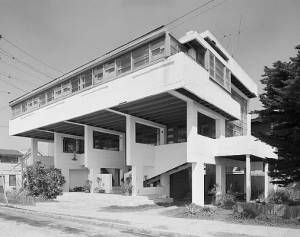
Beginning in the late 1920s, the International Style found a receptive audience on the other side of the Atlantic. The Austrian architects Richard Neutra and R.M. Schindler made their way to the United States in the 1910s, finding work first with Frank Lloyd Wright before settling in southern California. Keeping in touch with design trends in Europe, they soon each became pioneers of the International Style, as both were commissioned by the progressive doctor Philip Lovell, Schindler for Lovell's Beach House in Newport Beach in 1926 and Neutra for the Lovell Health House in Los Angeles, finished in 1929, a massive cliffside residence that was also one of the first buildings to use gunite (sprayed concrete). Likewise, in Philadelphia, the Swiss architect William Lescaze formed a brief partnership with George Howe, where the former designed the new office tower for the Philadelphia Savings Fund Society (PSFS Building), the first completed skyscraper to use the new architecture. But these examples were few and far between; the American attachment to classicism (and, by extension, Art Deco as its modern incarnation) meant that the International Style would not fully catch on in the USA until after World War II.
The International Style: Concepts, Styles, and Trends
Principles of Building Design
International Style architecture is often described as "minimalist" due to the tendency of its adherents to design buildings that were devoid of all ornament and reduced to their most basic structural elements. Such buildings often make use of large expanses of unbroken windows and use other elements like cantilevers to help eliminate the distinction between interior and exterior space as much as possible and to bring the inhabitants closer to nature, even when indoors. The use of mass-produced industrial materials - principally steel, concrete, and glass - was pivotal in permitting the kinds of construction that would support such a design program. Furthermore, the use of mass-produced (and sometimes prefabricated) materials had the potential to be more efficiently and cheaply manufactured than craft-based, traditional ones, thus practically and symbolically becoming proof of modern innovation and advancement.
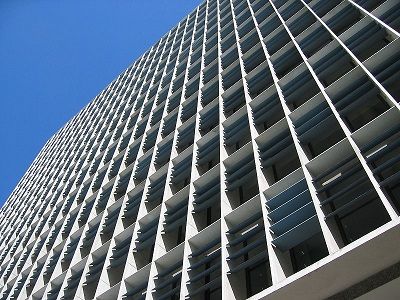
Le Corbusier's rise to prominence among modern architects came in part because of his ability to elucidate and disseminate a set of principles for the movement, which he called "The Five Points of a New Architecture" and intended for use in buildings of any scale. The foundation of the Five Points was the use of pilotis, or a point-support structure of thin columns of steel or reinforced concrete. This enabled the second point, the free plan, by freeing up floor space for maximum flexibility; as well as the third point, a free facade, since the point supports meant that there was no need for load-bearing exterior walls. Le Corbusier preferred to blur the boundary between exterior and interior, so the fourth point of his system emphasized the use of ribbon windows (or a curtain wall), and to emphasize the building's link to nature, a roof terrace constituted the fifth point. This system is best illustrated in Le Corbusier's small single-family houses built in the 1920s. In addition, Le Corbusier attracted many other followers on both sides of the Atlantic with the dissemination of Vers une architecture, particularly in Latin America. In Brazil, for example, Lucio Costa and Oscar Niemeyer became some of his closest collaborators, with Costa inviting Le Corbusier to Rio de Janeiro in 1935 to oversee the design of the new offices of the Ministry of Education and Health, a skyscraper that demonstrates the Five Points as clearly as any one of Le Corbusier's largest works built before 1945.
Transformative and Political Aspects of the International Style
From the beginning, the International Style was often associated with political movements, especially socialist and communist causes and regimes. Its revolutionary character in the years following World War I and the notion that architecture should be transformative in serving society and advancing the welfare of the working classes invited common ground between its advocates and the political left. The designs of Russian Constructivists provide some of the earliest examples, but others soon followed: the Bauhaus' initial manifesto featured a woodcut as its frontispiece by Lyonel Feininger called the Cathedral of Socialism (1919), and one model of the workshops at the school were the collective medieval craft guilds. Many of the Bauhaus' faculty were supported by the Social Democratic Party in Germany, and the school's various moves and eventual closure were prompted by political antagonism from the right. Many modern architects went to the Soviet Union in the 1920s and early 1930s to assist in the construction of new Soviet institutions and industrial cities (and to flee the Nazis), until Joseph Stalin kicked the foreigners out of Russia in 1936 and began to promote the heavy classicism called Socialist Realism. By the end of the 1930s Walter Gropius, Marcel Breuer, Ludwig Mies van der Rohe, and a host of other leaders of the International Style moved to the United States in order to flee persecution.
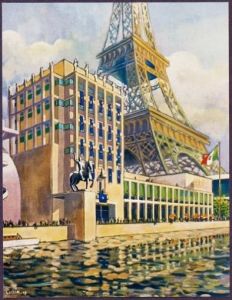
On the other hand, the attraction of the International Style caused many of the Italian Rationalists such as Giuseppe Terragni to seek Mussolini's blessing to adopt it as the official architecture of Italian Fascism, though this never came to pass. Terragni's Casa del Fascio in Como, Italy (1934) and Marcello Piacentini's Italian Pavilion for the 1937 Paris World's Fair (officially the Exposition Internationale des Arts et Techniques) are some of the best examples of an attempt to equate Fascism with the International Style.
Le Corbusier himself remains difficult to pin down politically. Supported by French industrialists, such as the Voisin car company, and his faith in the Taylorist and Fordist systems of mass-production of consumer goods, Le Corbusier became particularly interested in the adoption of International Style architecture on a vast scale in the aftermath of World War I. He proposed the construction of entire cities using the building principles outlined in his Five Points in various schemes throughout the 1920s. In the first of these, the Contemporary City for Three Million Inhabitants (1922), Le Corbusier envisioned a metropolis anchored by a grid of cruciform-plan, curtain-walled skyscrapers, housing office space and residences, set within a park-like setting crisscrossed by a grid of broad avenues. Low-rise apartment blocks set at right angles to each other snaked around the perimeter of the high-rise core. In the very center, a massive multistory transportation hub served simultaneously as a highway interchange, train station, and airport runway. Le Corbusier would continue to refine these urban schemes, some purely theoretical and some designed for reconfiguring specific cities, most notably his Plan Voisin for Paris, presented at the 1925 Exposition Internationale des Arts Décoratifs et Industriels Modernes, and five years later in his book The Radiant City (1930). In the late 1920s, Le Corbusier visited the Soviet Union and won the commission for the Centrosoyuz building in Moscow, flirting with Communism throughout the 1930s, especially after the stock market crash of 1929. When the Vichy regime came to power in France in 1940, Le Corbusier offered his services to Marshal Philippe Petain's pro-Nazi government, along with grand schemes for the redevelopment of Algiers, but was rebuffed. Amazingly, this attempt at collaboration did not seem to taint his standing amongst designers and critics in the postwar era, when he largely steered clear of politics.
Naming the New Architecture
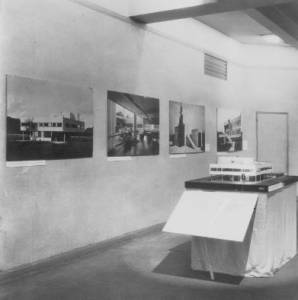
As the 1920s developed, the International Style remained known amongst its founders in Europe under various monikers, including Functionalism, Neue Sachlichkeit (or New Objectivity), De Stijl (in the Netherlands, where architects were intimately connected with painters under the same movement), and Rationalism (as it was known in Italy due to its honest revelation of structure and space). In 1932, after extensive travels in Europe, the young art historians Henry-Russell Hitchcock and Philip Johnson curated an exhibition at the new Museum of Modern Art in New York called Modern Architecture - International Exhibition, subsequently releasing a book entitled The International Style: Architecture Since 1922 that described the new architecture as a distinct movement in modern design. It featured many of the movement's key figures in France, the Netherlands, Czechoslovakia, Germany, Finland, and the United States. Hitchcock and Johnson described the International Style purely in formal terms: of volume rather than mass, the exclusion of applied ornament, and emphasizing balance rather than symmetry, saying little of the common use of industrial materials used or the social implications of this strand of modernism. Perhaps as a result, the International Style never encountered questions as to its potential leftist political content in postwar America. The exhibition went on a six-year tour after its six-week run at MoMA, the first traveling show of architecture in the USA, and the book gave the International Style its now-common name.
Later Developments - After The International Style
An "Unofficial" American Architecture
During World War II, many of the International Style's founders found new life attached to American institutions: Gropius and Breuer at Harvard and Mies at the Illinois Institute of Technology in Chicago, where they trained a new generation of Americans in the principles of the International Style. Their own practices also soon expanded in a climate of unparalleled economic growth in the United States. Mies, for example, was occupied with not only the planning and building of IIT's campus until 1956, but received the important commissions for the Farnsworth House in Plano, Illinois (1945-51), the Lake Shore Drive Apartments in Chicago (1949-51), the Seagram Building in New York (1954-58), and the development of Lafayette Park in Detroit (1956-63). His towering reputation inspired many emulators, particularly in skyscraper design: Skidmore, Owings and Merrill, popularly known as SOM, followed his paradigm so closely that they were nicknamed in the profession as "Sons Of Mies."
Emptied, in postwar America, of its mostly leftist connotations, the International Style became the ideal architectural vocabulary for the new car-oriented consumer culture. Its large expanses of glass and reliance on industrial construction made it an ideal movement for the minimalist pavilions of roadside businesses, including gas stations and fast-food restaurants that soon populated the suburbs and new interstate highways. Its ability to be erected cheaply and quickly using mass-production methods made it a preferred mode of design for new institutional structures, such as those on the expanding American college campuses needing to accommodate growing student populations thanks to the GI Bill. By 1961, the pervasiveness of the International Style in the American landscape meant that the eminent architectural historian Vincent Scully could even title a scholarly assessment published that year called Modern Architecture - The Architecture of Democracy.
Global Expansion
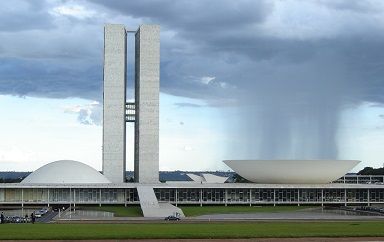
Even before World War II, the International Style had found sympathetic designers in Latin America. In 1935, Le Corbusier had been invited to supervise a team of Brazilian architects led by Lucio Costa on the design of the new Ministry of Education and Health in Rio de Janeiro, which brought the new movement to Brazil. Costa and his student Oscar Niemeyer continued to experiment with the International Style throughout the following decades, eventually collaborating between 1956 and 1960 on the plans for Brasilia, the country's new capital built entirely from a blank slate using the massive urban scale of auto transport similar to the early schemes of Le Corbusier of the 1920s. After 1950, Le Corbusier largely steered clear of high-level politics, focusing instead on individual clients. He also turned towards a rough-hewn naked concrete aesthetic called beton brut, a forerunner of Brutalism, which he employed in structures such as his innovative housing block called the Unite d'Habitation in Marseilles (1947-52) and the famous chapel Notre-Dame-du-Haut in Ronchamp, France (1950-55), but also brought to India in his work designing anew the provincial capital of Chandigarh (1951-61). During his time there Le Corbusier found many South Asian designers interested in his work, Balkrishna Doshi being one of most prominent. By the end of the 1950s, the International Style had become a truly global paradigm of modernism, the standard by which developing nations measured their architecture against the achievements of the traditional Western powers.
The Decline of the International Style
The widespread acceptance of the International Style was destined to provoke a reaction. Its emphasis on the glass-and-steel prismatic form, particularly in tall buildings, did not lend itself to variation. Instead it produced a vapid monotony that eventually proved soulless to designers and inhabitants alike, especially when used on a vast scale in low-income housing, as well as disorienting, as it eliminated the distinction of individual buildings to serve as geographic landmarks. In 1966, the architect Robert Venturi's influential Complexity and Contradiction in Architecture ridiculed the International Style, turning Mies' famous dictum "Less is more" around with the quip "Less is a bore." When employed on such a large scale, the International Style failed to actively improve the living conditions of its inhabitants, discrediting the claims of its founders that it might actively serve as a vehicle for social and economic transformation. Likewise, the abandonment of the human scale in favor of isolated structures set in parklike surroundings and accessible largely by automobile transportation also discouraged the building of communities and neighborhoods in favor of the isolation of entire sectors of urban populations within towers.
The heyday of the International Style in the 1950s also coincided with some of the biggest concerted endeavors worldwide towards urban planning, a process that in large part proved devastating to established communities by destroying the organically-evolving urban fabric. The confining, often drab character of much International Style architecture became a symbol of the blight produced by such efforts where arguably none had existed before. These effects were famously and meticulously chronicled in Jane Jacobs' critique The Death and Life of Great American Cities (1961), which, along with grassroots activism, managed to stave off the modernist reshaping of lower Manhattan in the fashion of the International Style. Even its most ardent champions such as Philip Johnson eventually turned against it - witness, for example, his AT&T (now Sony) Building in New York (1978), with a roofline reminiscent of a Chippendale highboy.
New Directions for Architecture
Some architects, such as Louis Kahn and Paul Rudolph, sought different directions in the 1950s and '60s. Kahn, raised and based in Philadelphia, became known for his designs that "brought back the wall" as opposed to the vast expanses of curtain-wall windows. Kahn's buildings, such as his Kimbell Art Museum in Fort Worth, Texas (1966-72) and the National Parliament Building in Dhaka, Bangladesh (1961-82) modulate light, volume, and space in a highly sensitive manner, often with more traditional materials such as brick and wood - ubiquitous in both the official and vernacular architecture around Philadelphia. Rudolph, who became dean of the Yale School of Art & Architecture in 1958, was fascinated with the large-scale use of concrete and is sometimes looked to as one of the founders of Brutalism, whose rough-hewn surfaces became extremely popular in the late 1960s and '70s as one of the first recognizable aesthetics of postmodernism.
Legacy
The International Style is usually regarded as the high point of modernist architecture, the end product of a search to find a mode of expression in building suited to the 20th century that jettisoned the forms and ornament of the past. By the 1950s its formal aspects had become nearly synonymous with the term "modern architecture." But it promoted a troubling universality when applied too frequently as a cure-all to social and economic problems, revealing the limitations of architecture as a genuine political and cultural force. In the generations after 1960, a more playful treatment of historical styles, monumentality, and traditional materials would come to define much of postmodern architecture. While the International Style still exerts a powerful influence on current architects, few would now take its ideas and aesthetic completely at face value.
Useful Resources on The International Style
- The International StyleOur PickBy Henry Russell Hitchcock and Philip Johnson
- International Style (Taschen's World Architecture)Our PickBy Hasan-Uddin Kahn and Philip Jodido
- Le Corbusier and the Maisons JaoulBy Caroline Benton
 Ask The Art Story AI
Ask The Art Story AI











